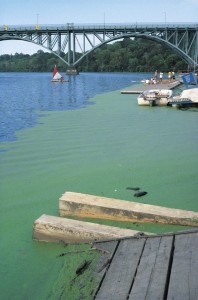Unchecked algal blooms are a green menace
September 21, 2015The Lehigh Valley region is blessed with an abundance of water, and for many residents, the summer involves relaxing at a lake, river, pond or creek — be it fishing, boating, swimming, or just sitting next to the water.
next to the water.
If you’ve spent any of that time in mid-July and August, you’ve likely seen a fair amount of green scum in that water. It’s an algal bloom: tiny plants feeding off a combination of ample sunlight and an abundance of nutrients.
In many cases, these blooms are worsening each year. Much of it can be blamed on the overuse of fertilizer, which washes off lawns, gardens and fields and into our waterways. The scientific term is “eutrophication”: the nutrient enrichment of bodies of water.
These blooms often become toxic, because the algae grows out of control. At night, when sunlight isn’t available, the algae uses up oxygen in the water — leaving none for the fish. As the fish die, they decompose — adding to the nutrients in the water and worsening the problem. Blue-green algal blooms (which are actually classified as a type of bacteria) have also been linked to rashes and, in some cases, can make people and animals sick if untreated water is ingested.
We recently read a story that takes algal blooms one step further: some researchers think they may have contributed to mass extinctions millions of years ago.
It’s a sobering thought, albeit a controversial one —not all scientists agree on the timing of the blooms or their possible link to extinction. However, they do agree on one thing: unchecked algal blooms are toxic to aquatic life. And that alone is reason enough to reduce or eliminate the application of lawn and garden fertilizers.
This fall, rethink your lawn maintenance routines. Try applying a light layer of compost instead of chemical fertilizers. Don’t allow leaves and grass clippings to wash into streams, ponds or lakes. Consider building a buffer zone, which will trap nutrients before they reach rivers, ponds, lakes and streams.
Inside the home, switch to shampoos and detergents that are free of phosphorous —another type of nutrient that washes into our waterways.
We may not be able to eliminate algal blooms. But by working together, we can certainly reduce their impact.